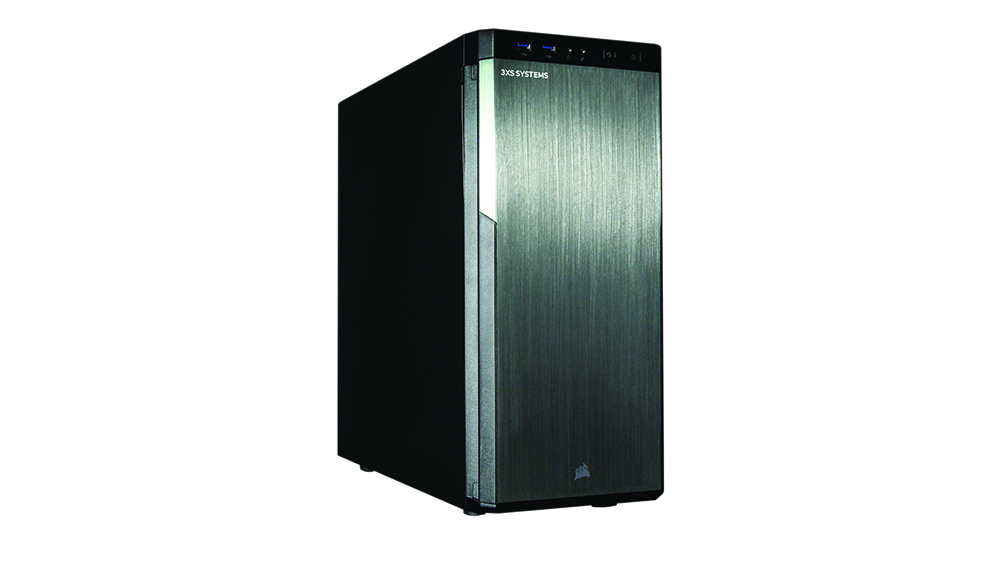Scan 3XS GW-HT20 review
Unbeatable performance courtesy of the all-new Intel Core i7-6950X and a talented supporting cast


If you’re looking for a content-creation workstation that won’t stutter with any task you might hand it, the GW-HT20 should be on a shortlist of one.
-
+
Virtually unbeatable performance; Well outfitted with ports and storage;
-
-
Very expensive;

Until Intel announced its Broadwell-E variant of its Core processors, if you wanted more than four cores in your PC you had to fall back two generations from Skylake to Haswell. The fifth-generation Broadwell version of Xeon arrived only recently, with up to 22 cores, and Armari used it to stunning effect in its Magnetar M44-AW1200G2. Now we have our first taste of this "Broadwell-E" variant in Core i7 form, with Scan's GW-HT20.
Scan has gone straight for the jugular by including the top member of the new Core i7 range, the 6950X. Nominally, this runs at 3GHz with a maximum 3.5GHz Turbo mode, but as is usual for Core i7 workstations, Scan has permanently clocked the processor to 4.2GHz. This is backed by a three-year warranty (first year on-site; years two and three return-to-base), providing buyers with plenty of reassurance.
More importantly, it's stupendously powerful. With ten physical cores, doubling to 20 virtual cores via Hyper-Threading, this chip promises performance whether your application requires single-core clock speed or multiple core quantity.
The potent processor is backed by 32GB of 2,666MHz DDR4 SDRAM. This is supplied as four 8GB modules, so there are four more DIMM slots free for upgrade to the 64GB maximum that the Asus X99-A/USB 3.1 motherboard allows. As its name suggests, this motherboard also sports a pair of USB 3.1 ports, on the rear backplane, although not of the Type-C variety. Instead, the backwards-compatible Type A USB socket is used. Nevertheless, ultra-fast external storage can easily be connected. There's one M.2 Socket 3 and SATA Express inside for fast internal storage too.
Scan hasn't skimped on the graphics, either. A PNY Nvidia Quadro M5000 is included currently, the fastest sub-2,000 professional card on the market. This sports 8GB of GDDR5 frame buffer with 211GB/sec of bandwidth available. Most importantly, there are 2,048 CUDA cores on tap, which will make real-time previews of 3D models very smooth to work with.Scan has invested in a 256GB Samsung SM950 Pro M.2 NVMe SSD a blistering performer in our data-transfer tests with a 7,200rpm 2TB Seagate Desktop HD.15 mechanical hard disk provided for general data. A Samsung SH-224FB DVD writer and multi-format memory card reader round off a comprehensive set of storage options.
All this pushed the GW-HT20 to phenomenal scores in our tests, with 2,182 in the CPU portion of Maxon Cinebench R15. Sure, this can't match a top-end dual-socket system such as the Magnetar M44-AW1200G2, but it's a brilliant result for a single-chip machine, and indicates that an independent 3D content creator can output their animations quickly.
In our media benchmarks, the GW-HT20 manages results that have only been bettered by Armari's monster workstation. The overall score of 339 is jaw-dropping, with an image-editing result of 160 even faster than the Armari. With 405 in the multi-tasking portion and 329 for video encoding, this is a system that doesn't hang around in any area of everyday computing.
It's going to be amazing for 3D modelling, too. The GW-HT20 achieved 226.14 in the OpenGL portion of Maxon Cinebench R15 the highest result we've seen and SPECviewperf 12 scores are similarly stunning. The maya-04 score of 95.22 is also the fastest we've seen by a significant margin, as are 161.37 in sw-03, 136.56 in catia-04, 101.68 in creo-01, and 121.52 in snx-02. The result of 65.71 in showcase-01 just pips the best, and with 9.77 in energy-01 and 43.35 in medical-01, there's no professional real-time 3D visualisation category that this workstation won't accelerate as fast or faster than any other system currently on the market.
Overall, the Scan 3XS GW-HT20 is the second-fastest workstation we've ever seen, only falling behind the Armari due to the advantages of dual sockets when rendering or encoding. But the Armari cost 9,596 inc VAT. At less than half the price, the Scan even though it pushes past the 4,000 mark when you take VAT into consideration offers phenomenal value. If you're looking for a content-creation workstation that won't stutter with any task you might hand it, the GW-HT20 should be on a shortlist of one.
Verdict
If you’re looking for a content-creation workstation that won’t stutter with any task you might hand it, the GW-HT20 should be on a shortlist of one.
Get the ITPro daily newsletter
Sign up today and you will receive a free copy of our Future Focus 2025 report - the leading guidance on AI, cybersecurity and other IT challenges as per 700+ senior executives
Dr James Morris has worked as a technology journalist for over 25 years, including spending nine years on the staff of market-leading computer magazine PC Pro, the last five of which were as the publication’s editor. He specialises in enterprise-grade software and hardware, with a particular focus on content creation. He launched a pioneering video channel for HEXUS.net in 2006 and ran the video reviews channel for TrustedReviews.com for four years. He also runs a successful online digital content and commercial video production company, t-zero communications Ltd.
Dr Morris is a prolific technology writer and contributes commercial content for major IT brands including AMD, BlackBerry, Dell, Cognizant, HP, and IBM. He published a book on artificial intelligence, Can Computers Create Art? in 2009. He is also an academic, and is currently Pathway Director of the MA, Interactive Journalism at City, University of London.
Previously, he was course leader for the BA in Web Media Production at Ravensbourne University. He has a PhD in Philosophy, Art and Social Thought from the European Graduate School in Switzerland, a Master's in Media Arts from the New School in New York, USA, and a Bachelor's in Social Anthropology from the London School of Economics.
Dr. Morris can be found on Twitter at @Cyberwest, or emailed at j@tzero.co.uk
-
 Westcon-Comstor and Vectra AI launch brace of new channel initiatives
Westcon-Comstor and Vectra AI launch brace of new channel initiativesNews Westcon-Comstor and Vectra AI have announced the launch of two new channel growth initiatives focused on the managed security service provider (MSSP) space and AWS Marketplace.
By Daniel Todd Published
-
 Third time lucky? Microsoft finally begins roll-out of controversial Recall feature
Third time lucky? Microsoft finally begins roll-out of controversial Recall featureNews The Windows Recall feature has been plagued by setbacks and backlash from security professionals
By Emma Woollacott Published
-
 The UK government wants quantum technology out of the lab and in the hands of enterprises
The UK government wants quantum technology out of the lab and in the hands of enterprisesNews The UK government has unveiled plans to invest £121 million in quantum computing projects in an effort to drive real-world applications and adoption rates.
By Emma Woollacott Published